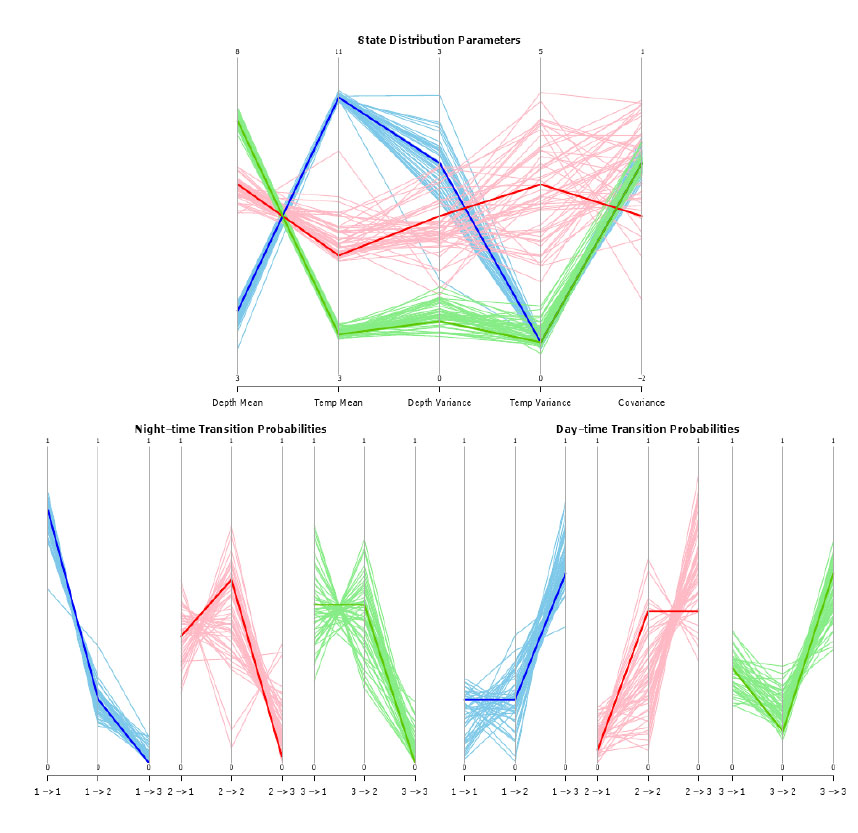
Ecological Archives A025-075-A2
Joe Scutt Phillips, Toby A. Patterson, Bruno Leroy, Graham M. Pilling, and Simon J. Nicol. 2015. Objective classification of latent behavioral states in bio-logging data using multivariate-normal hidden Markov models. Ecological Applications 25:1244–1258. http://dx.doi.org/10.1890/14-0862.1
Appendix B. Simulation experiments: Full parameter tables for simulations and results from the second, more complex simulation scenario two.
Artificial data sets were generated under two different scenarios, as described in the main article. Full parameters are given in the following tables. A parallel coordinate plot showing the true values and spread of estimated parameters is given in Fig. B1 for scenario two. The corresponding figure for scenario one is given in the main article.
Table B1. Scenario one simulation parameters.
State |
Multivariate mean μ |
Variance-covariance matrix ∑ |
Transition probabilities |
|||||||||
|
Parameter |
True |
Estimate Mean |
Estimate Stan dev. |
Parameter |
True
|
Estimate Mean |
Estimate Stan dev. |
Parameter |
True |
Estimate Mean |
Estimate Stan dev. |
State 1- Persistent Shallow State |
Depth Amplitude
Water Temperature |
4
10 |
4.000
9.994 |
0.11
0.05 |
Depth Amplitude
Temperature
Covariance |
2
0.5
0 |
2.019
0.585
-0.015 |
0.17
0.08
0.08 |
1->1
1->2
|
0.8
0.2 |
0.752
0.248
|
0.04
0.04 |
State 2- Persistent Deep State |
Depth Amplitude
Water Temperature |
6
6 |
6.133
6.025 |
0.11
0.18 |
Depth Amplitude
Temperature
Covariance |
1.5
3
-0.5 |
1.507
3.119
-0.182 |
0.17
0.58
0.32 |
2->1
2->2 |
0.3
0.7 |
0.305
0.695 |
0.04
0.04 |
Table B2. Scenario two state distribution parameters.
State |
Multivariate mean μ |
Variance-covariance matrix ∑ |
||||||
|
Parameter |
True |
Estimate Mean |
Estimate Stan dev. |
Parameter |
True
|
Estimate Mean |
Estimate Stan dev. |
State 1- Persistent Shallow State |
Depth Amplitude
Water Temperature |
4
10 |
3.931
10.016 |
0.14
0.06 |
Depth Amplitude
Temperature
Covariance |
2
0.5
0 |
1.949
0.517
0.021 |
0.27
0.06
0.10 |
State 2- Transitive Searching State |
Depth Amplitude
Water Temperature |
6
6 |
5.921
6.478 |
0.16
0.51 |
Depth Amplitude
Temperature
Covariance |
1.5
3
-0.5 |
1.398
2.892
-0.012 |
0.27
0.77
0.42 |
State 3- Persistent Deep State |
Depth Amplitude
Water Temperature |
7
4 |
6.989
4.050 |
0.09
0.10 |
Depth Amplitude
Temperature
Covariance |
0.5
0.5
0 |
0.564
0.619
0.008 |
0.11
0.16
0.07 |
Table B3. Scenario two transition matrix parameters.
State |
Day-time transition probabilities |
Night-time transition probabilities |
||||||
|
Parameter |
True |
Estimate Mean |
Estimate Stan dev. |
Parameter |
True
|
Estimate Mean |
Estimate Stan dev. |
State 1- Persistent Shallow State |
1->1 1->2 1->3
|
0.2 0.2 0.6 |
0.152 0.203 0.645 |
0.07 0.08 0.08 |
1->1 1->2 1->3
|
0.8 0.2 0.0 |
0.780 0.193 0.028 |
0.05 0.04 0.02 |
State 2- Transitive Searching State |
2->1 2->2 2->3
|
0.04 0.48 0.48 |
0.084 0.0274 0.642 |
0.05 0.14 0.14 |
2->1 2->2 2->3
|
0.4 0.58 0.02 |
0.402 0.478 0.121 |
0.08 0.14 0.08 |
State 3- Persistent Deep State |
3->1 3->2 3->3 |
0.3 0.1 0.6 |
0.289 0.169 0.542 |
0.06 0.05 0.08 |
3->1 3->2 3->3 |
0.5 0.5 0.0 |
0.492 0.466 0.042 |
0.11 0.11 0.05 |

Fig. B1. Parallel coordinate plots showing true and estimated parameter values for 50 repetitions of simulation scenario two.